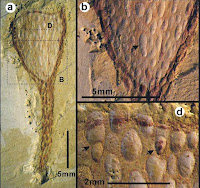Lophophorates are animals which feed using a filter called a
lophophore, which comprises a number of setae covered tentacles, to extract
food from water. The group includes the shelled Brachiopods, the worm-like
Phoronids, the minute Entoprocts and colonial Bryozoans, and has been shown by
molecular and embryonic evidence to be related to the Molluscs and Annelids.
Within the Lophophorates the Phoronids and Brachiopods are thought to be
closely related, with some studied suggesting that the Phoronids should be
regarded as a shell-less subgroup of the Brachiopods.
In a paper published in the journal Scientific Reports on 15 May
2014, a group of scientists led by Zhi-Fei Zhang of the Early Life Institute, StateKey Laboratory of Continental Dynamics and Department of Geology at Northwest University and the Nanjing Institute of Geology and Palaeontology of the
Chinese Academy of Sciences, describe a Lophophorate Animal from the Early
Cambrian Heilinpu Formation of the Haikou, Erjie, Shankou and Chengjiang areas,
around Kunming, in Yunnan Province, China; deposits known as the ‘ChengjiangLagerstätte’
or ‘Chengjiang Fauna’ due to the large number of exceptionally well preserved
fossils found there.
The species is described from over 700 specimens, and is given the
name Yuganotheca elegans, where ‘Yuganotheca’ means ‘Yugan’s shell’ in
honour of the late Yugan Jin for his work on the Brachiopods of the Chengjiang
Fauna, and ‘elegans’ means
‘beautiful’ (though this is not specifically explained).
Yuganotheca elegans has a pair of muscular ‘valves’ which encase its lophophore, similar
to the shell valves of Brachiopods, but lacking a mineralized shell and
possessing a fringe of setae around their matgins. Instead these valves are
covered in agglutinated sand particles, a strategy unknown in Brachiopods, but
common in Phoronids, which often use agglutinated particles to cover the upper
part of their trunks, which must be projected above the sediment when feeding.
The arrangement of the lophophore tentacles is different from that seen in
Brachiopods, and appears to have been capable of projecting into passing
currants, whereas Brachiopods open and shut their shells to pump water through
the lophophore. Behind the valves is a muscular collar, then a straight conical
tube-like trunk and a long flexible pedicle (tail).
Yuganotheca elegans from the early Cambrian Chengjiang Lagerstätte, Yunnan, China.
Arrows point to the borders between the upper pair of valves (Avs), median
collar (Mc), lower conical tube (Pc), and pedicle (Pe); M = mouth; Lo =
lophophore; Va = visceral area; Dg = the terminal pedicle bulb with adhered
grains; Se = setae; Ten = tentacles. (a), Holotype, compare to (b). (c–d),part
and counterpart; note the lophophore imprint in (d). (e), compare to (d). (f) complete
individual with well-developed pedicle. Zhang et al. (2014).
Some of the specimens show a dark u-shaped structure within the
collar area, which Zhang et al. interpret
as a an alimentary canal originating from a mouth within the lophophore
structure and terminating at an anus on the lateral side of the body, an arrangement
similar to that seen in Phoronids.
Yuganotheca elegans from the early Cambrian Chengjiang Lagerstätte, Yunnan, China.
Arrows point to the borders between the anterior pair of valves, median collar,
lower conical tube, and (in 2a, b, d) pedicle; all scale bars are 5 mm. (a)
Nearly complete specimen. (b) Specimen showing the central lumen (Pc) and the
terminal bulb (Dg) of the pedicle. (c–d) Specimens showing the oblique growth
fila of the lower cone and gut remains; note U-shaped lineation interpreted as
the digestive tract marked by left (Lg) and right (Rg) parts; note the putative
location of mouth (M) and probable anus (?A). (e) Specimen showing well-preserved
ventral mantle canals. (f) Interior dorsal valve. Zhang et al. (2014).
The close relationship between Brachiopods and Phoronids suggested
by molecular data has suggested that Brachiopods arose from a Phoronid-like
ancestor, although how a shelled Brachiopod (even a vermiform one such as a
Lingulid, which have worm-like bodies and phosphatic shells covering only their
exposed foreparts) arose from a Phoronid-like animal lacking the bivalved
structure which defines Brachiopods has been hard to assess. Yuganotheca elegans appears to bridge this
gap, possessing a pair unmineralized valves surrounding the lophophore
structure, combined with a mixture of other traits seen in Phoronids and
Brachiopods, such as a Phoronid-like U-shaped gut and agglutinated covering and
a Lingulid-like pedicle anchoring it to the sediment.
Artistic reconstruction of Yuganotheca elegans with inferred semi-infaunal life position. Dong-Jing Fu
in Zhang et al. (2015).
The valves of Yuganotheca elegans show
clear affinities with those of Brachiopods, while the elongate pedicle is
similar to the tails of Phoronids and Lingulid Brachiopods, but the rigid
conical section of the body, which is interpreted as having been used to hold
the valves and lophophore above the sediment, is not found in either group.
However it is reminiscent of phosphatic tubes produced by some Tommotiids, an
enigmatic group of Cambrian fossils, suggesting that these may be relatives of
the Phoronid/Brachiopod group.
See also…
The Lophotrochozoa are a diverse group of Invertebrate animals indicated
to have a common ancestry by genetic analysis. The group includes the
Annelida, Mollusca, Bryozoa, Cycliophora, Brachiopoda, Entoprocta and
Phoronida. Within this group several groups are united by the presence
of a crown of tentacles (the Lophophore) surrounding the mouth, which
continuously opens and shuts while...
Brachiopods (or Lampshells) superficially resemble Bivalve Molluscs,
though they are not closely related. They were abundant in the seas of
the Palaeozoic, often dominating benthic faunas, but today are
comparatively rare, and seldom seem outside the...
Follow Sciency Thoughts on Facebook.






